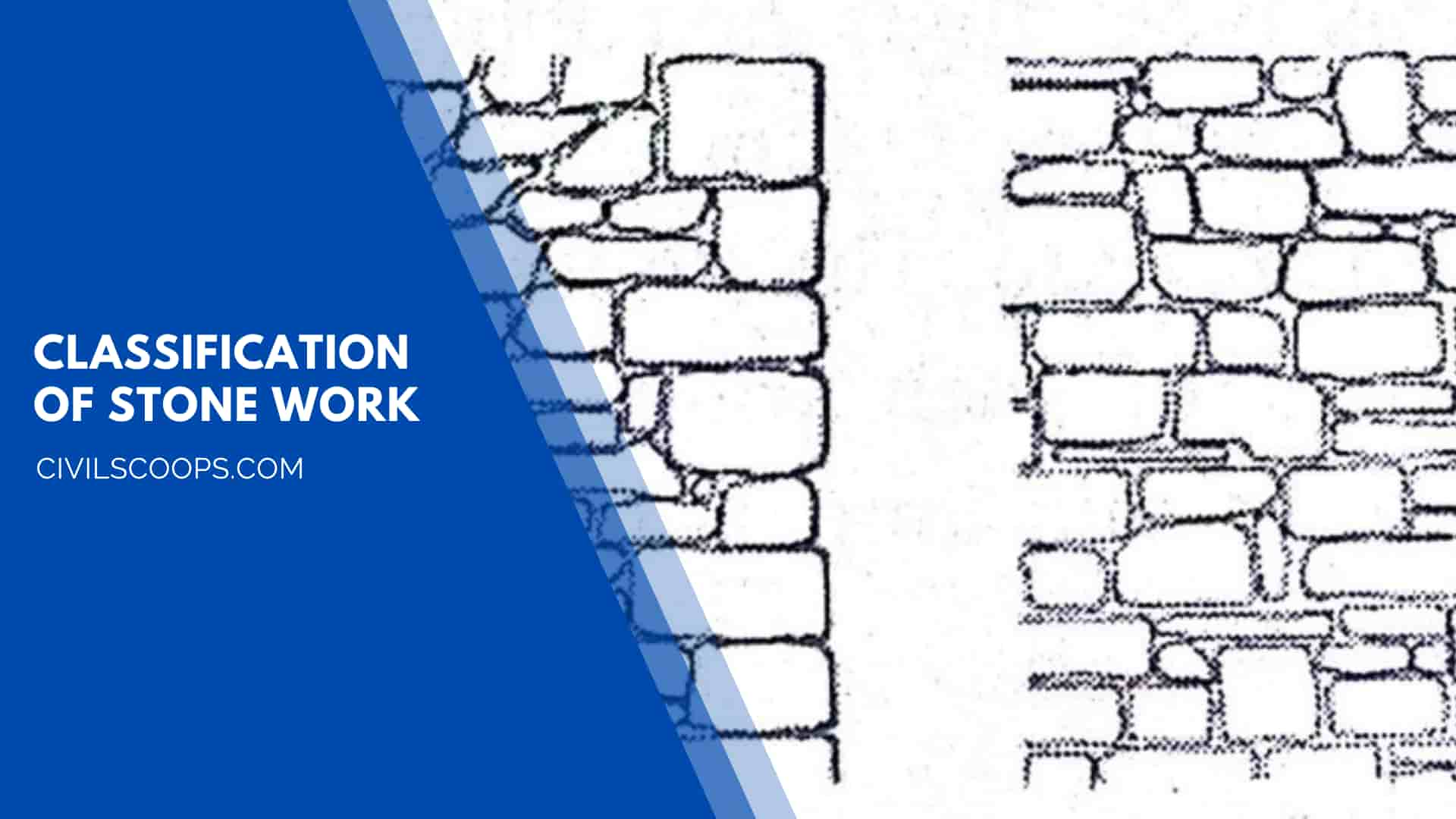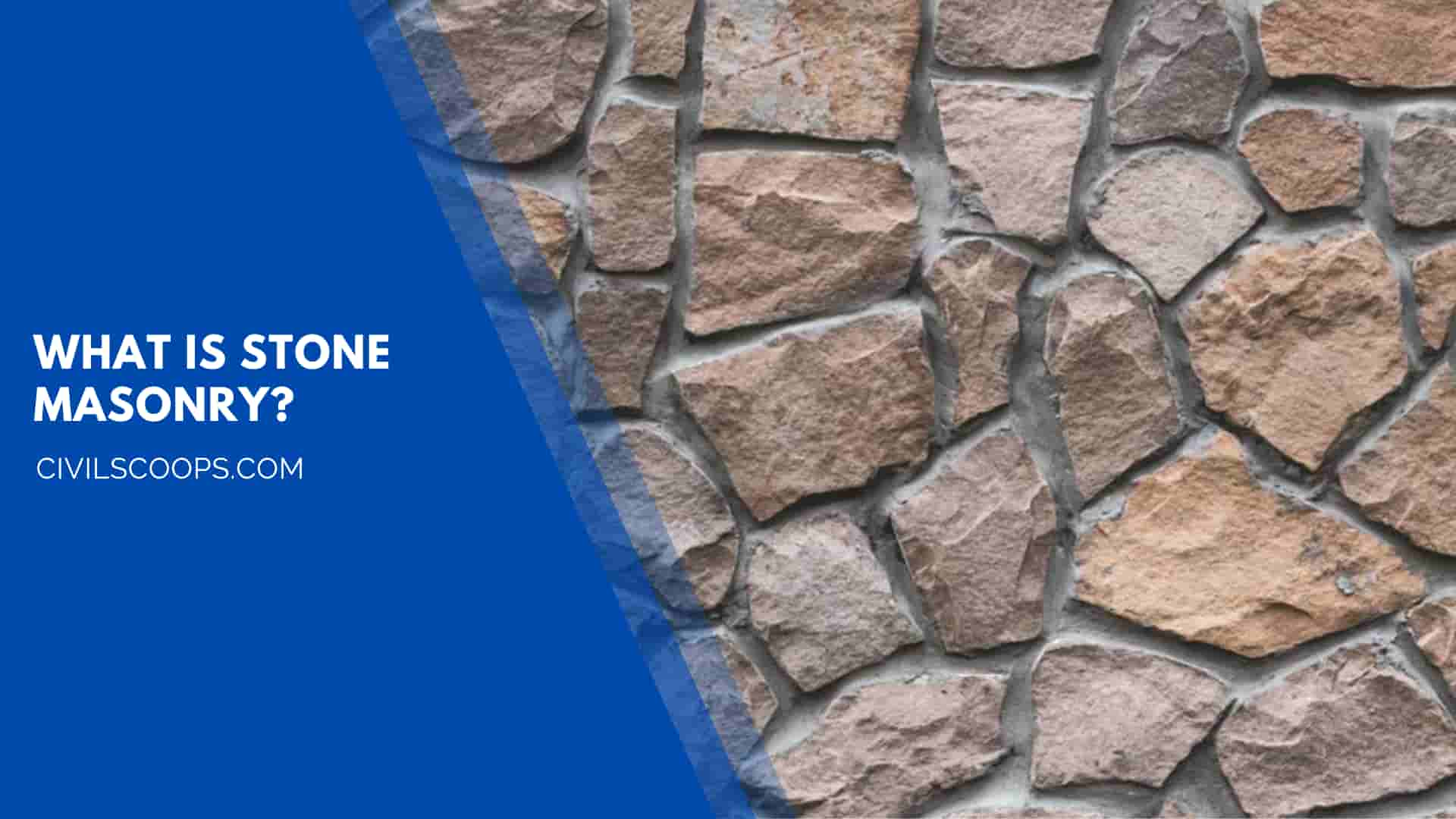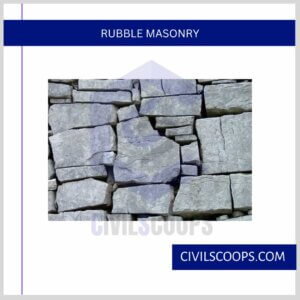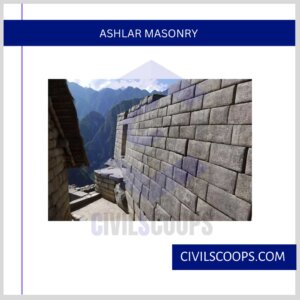Classification of Stone Work | What Is Stone Masonry

Table of Contents
What Is Stone Masonry?

The construction of stones bonded together with mortar is termed stone masonry. Where the stones can be found in abundance in nature, on cutting and dressing to the proper shape, they provide an economical material for the construction of various building components such as walls, columns, tooting, arches, beams, etc.
Stone masonry being stronger, more durable, and weather-resistant, when compared with brick masonry, is used in the construction of piers, docks, dams’ lighthouses, and other marine structures.
Classification of Stone Work
Based on the arrangement of stones in the construction and the degree of refinement in the surface finish, the stone masonry can be classified broadly into the following two categories:
- Rubble Masonry
- Coursed Rubble
- Uncoursed Rubble
- Random Rubble
- Dry Rubble
- Polygonal Rubble
- Flint Rubble
- Ashlar Masonry
- Ashlar Fine
- Ashlar rough tooled
- Ashlar rock or quarry faced
- Ashlar Chamfered
- Ashlar block-in course
1. Rubble Masonry

In this type of construction, stones of irregular size are used. The stones as obtained from the quarry are taken to be used in the same form or are broken and shaped into suitable sizes by means of a hammer as the work proceeds. The strength of the rubble masonry mainly depends on:
- The quality of the mortar.
- The use of long stones at a frequent interval for proper bonding.
- The proper filing of the mortar between the spaces of stones.
1.1. Coursed Rubble Masonry
In this type of rubble masonry, the heights of stones vary from 50 mm to 20 cm. The stones are stored before the work commences.
The masonry work is then carried out in courses such that the stones in a particular course are of equal heights.
This type of masonry is used for the construction of public buildings and residential buildings. The coursed rubble masonry is further divided into three categories.
1.2. Coursed Rubble Masonry I Sort
In this type, stones of the same height are used, and the courses are of the same height. The facing stone is dressed by means of a hammer, and the brushings do not project by more than 40 mm. The thickness of the mortar joint does not exceed 10 mm.
1.3. Coursed Rubble Masonry H Sort
The stones to be used are of different heights. The courses need not be of equal heights. Only two stones are to be used to make up the height of one course. The thickness of the mortar joint is 12 mm.
1.4. Coursed Random Rubble III Sort:
The stones to be used arc of different heights, the minimum being 50 mm. The counts need not be of equal heights. Only three stones are to be used to make up the height of one course. The thickness of the mortar joint is 16 mm.
1.5. Uncoursed Rubble Masonry
In this type of rubble masonry, the stones arc not dressed. However, the arc is used as they are available from the quarry, except by knocking out some corners. The course arc not maintained regularly.
The larger stones are laid first, and the spaces between them are then filled by means of spalls. The wall is brought to a level every 30-50 cm.
This type of rubble masonry being cheaper is used for the construction of compound walls, garages, labor quarters, etc.
1.6. Random Rubble Masonry
In this type of rubble masonry, stones of irregular sizes and shapes are used. The stones are arranged to have a good appearance.
It is to be noted that more skill is required to make the masonry structurally stable. If the face stones are chisel dressed and the thickness of mortar joints does not exceed 6 mm, it is known as random rubble masonry, I sort.
If the face stones are hammer dressed and the thickness of mortar joints does not exceed 12 mm, it is known as random rubble masonry II sort. This type of masonry is used for the construction of residential buildings.
1.7. Dry Rubble Masonry
This is just similar in construction to the coursed rubble masonry III sorts except that no mortar is used in the joints. This type of construction is the cheapest, but it requires more skill in construction.
It is extensively used for compound walls pitching on bridge approaches, retaining walls, etc. In order to prevent the displacement of stones and to make the work more stable, the two courses at the top and about
50 cm in length at the ends are sometimes built-in mortar.
1.8. Polygonal Rubble Masonry
In this type of masonry, the stones are hammer dressed and the stones selected for face work are dressed in an irregular polygonal shape.
Thus, the face joints are seen running in an irregular shape in all directions. It is to be noted that more skill is required in this type of construction.
1.9. Flint Rubble Masonry
In this type of masonry, the stones are used as flints that are irregularly shaped nodules of silica. The width and thickness vary from 80 mm to 15 cm and the length varies from 15 to 30 cm.
2. Ashlar Masonry

This is costlier, high-grade, and superior-quality masonry. This is built from accurately dressed stones with uniform and very fine joints of about 3 mm thickness.
By arranging the stone blocks in various patterns, different types of appearances can be obtained. The backing of ashlar masonry walls may be built of ashlar or rubble masonry.
2.1. Ashlar Fine Masonry
All beds, joints, and face stones should be dressed perfectly so that they conform to the desired pattern. The size of the stones to be laid in regular courses should not be less than 300 mm in height.
The width of the stones should not be less than the height of the course, In addition, the length of the stones should be more than two times the height of the course.
Generally, face stones arc laid as headers and stretchers alternatively. The header comes under the middle portion of the stretchers.
In order to break the continuous vertical joints, the stones in the adjacent layers should have a lap of more than half of the height of the course.
All the joints, either horizontal or vertical, should be made of fine mortar with a maximum thickness of 3 mm. The broken edges of the stones should not be visible at the joints.
2.2. Ashlar Rough Tooled Masonry
The exposed faces of this type of masonry should be given a fine-dressed chisel drafting of about 25 mm in width. In between the drafts, portions should be roughly tooled. The joint thickness should be 6 mm.
2.3. Ashlar Rock or Quarry Faced Masonry
In this case, the exposed faces of the facing stones between the chisel draftings all around are left undressed. However, the projections of sizes more than 8 cm arc broken.
All other specifications regarding the sizes of the stones and the bond are kept similar to that of ashlar rough tooled masonry.
2.4. Ashlar Chamfered Masonry
In this type of ashlar masonry, the strip is provided as above. However, it is chamfered or beveled at an angle of 45 degrees by means of a chisel for a depth of about 25 mm.
Another strip 12 mm wide is then provided on the remaining exposed face of the stone and the surface inside this strip is left in the same form as received from the quarry.
The large bushings projecting out to more than 80 mm are removed by a hammer. A neat appearance of the grooved joints is obtained with the help of this type of construction.
Also Read: Stone Masonry vs Brick Masonry | What Is Brick Masonry | What Is Stone Masonry
2.5. Ashlar block-in course Masonry
This type of masonry occupies an intermediate position between rubble masonry and ashlar masonry. The faces of the stones are generally hammer dressed and the thickness of mortar joints does not exceed 6 mm.
The depth of courses varies from 20 to 30 cm. This type of construction is used for heavy engineering works.
[su_box title=”FAQ” style=”default” box_color=”#333333″ title_color=”#FFFFFF” radius=”3″ class=”” id=””]
What Are the Types of Stone Masonry?
Although there is a wide variety of different masonry techniques, stone masonry can be divided into two basic types – rubble masonry and ashlar masonry, each with its own subtypes.
What Are the Different Types of Stone Masonry?
Rubble Masonry
- Random Rubble Masonry.
- Square Rubble Masonry.
- Dry Rubble Masonry.
- Rough-Tooled Ashlars.
- Quarry-Faced or Rock-Faced Ashlars.
What Is Slipform Stone Masonry?
Slipform stonemasonry is a method for making a reinforced concrete wall with stone facing in which stones and mortar are built up in courses within reusable slipforms. It is a cross between traditional mortared stone wall and a veneered stone wall.
What Is Rubble Masonry?
Rubble stone is rough, uneven building stone not laid in regular courses. It may fill the core of a wall which is faced with unit masonry such as brick or ashlar. Some medieval cathedral walls have outer shells of ashlar with an inner backfill of mortarless rubble and dirt.
What Is Random Rubble Masonry?
Random rubble masonry:
Rubble masonry is the type of stone masonry in which either undressed or hammer dressed stones are used is called random rubble masonry.
What Is Ashlar Masonry?
Ashlar is finely dressed stone, either an individual stone that has been worked until squared, or a structure built from such stones. Ashlar is the finest stone masonry unit, generally rectangular cuboid, mentioned by Vitruvius as opus isodomum, or less frequently trapezoidal.
Types of Ashlar Masonry
Different types of ashlar masonry include coursed ashlar, where the stones are identical in each layer; random ashlar, where the stones seem to be placed without a regular pattern; and rough tooled ashlar, in which the facing surface of the stone has been tooled to look less finished.
Coursed Square Rubble Masonry
Coursed square rubble masonry
Squared rubble stone masonry consists of stones squared on all joints through facing methods of hammering or chiseling the stone. Squared rubble can consist of various sized stones and can be laid in equal courses, coursed every third or fourth stone, or uncoursed.
Uncoursed Rubble Masonry
Uncoursed rubble masonry
Uncoursed Rubble Masonry is the poorest form of stone masonry. The stones to be used for the work are directly obtained from the quarry, after merely knocking off weak corner and edges with the mason’s hammer. The stones are carefully laid so as to break joints as much as possible.
Is Stone Masonry?
Stonemasonry is essentially a type of construction technique that uses stones as the main material. Stones are cut, shaped, and placed to form structures and designs. Masons use them together with mortar to build foundations, walls, floors, and columns.
What Are the Three Types of Masonry?
Brick Masonry: Brick is the most popular material for masonry. They are known to be durable, long lasting, and have a classic look that has lasted the test of time.
Stone Masonry: Stone masonry can be either dressed or undressed.
Concrete Blocks: These blocks are much larger than stone and brick.
Polygonal Rubble Masonry
Polygonal Rubble Masonry
Polygonal rubble masonry. In this type, stones are hammer finished on the face to an irregular polygonal shape. If stones are roughly shaped to form rough fitting, such a work is called rough picked work. If stones are carefully shaped to form close fitting such a work is called close-picked work.
Flint Rubble Masonry
Flint, occasionally flintstone, is a sedimentary cryptocrystalline form of the mineral quartz, categorized as the variety of chert that occurs in chalk or marly limestone. Flint was widely used historically to make stone tools and start fires.
Ashlar Fine Masonry
Ashlar Fine Masonry
Ashlar masonry is a type of stone construction where all stones are dressed or cut to a uniform shape, size, and surface appearance. They are then laid in horizontal courses, or layers, with very little of a supporting substance called mortar between them. Ashlar masonry is a very old type of construction.
Ashlar Fine Tooled Masonry
Ashlar masonry is a type of stone masonry which is formed using finely dressed stones of same size, shape, and texture laid together in cement or lime mortar of equal size joints at right angles to each other.
Ashlar Rock or Quarry Faced Masonry
Quarry-Faced or Rock-Faced Ashlars
In quarry-faced ashlar masonry, the sides of the stone are finely dressed to give it a specific shape, while the face is undressed, raw, and essentially is left unchanged from the quarry. Unlike rough-tooled ashlar masonry, quarry-faced ashlar stone faces are completely untouched.
Ashlar Chamfered Masonry
Ashlar Chamfered Masonry
It is a special type of ashlar rock faced in which the strip provided around the perimeter of the exposed face is chamfered at an angle of 45 degree to a depth of 25 mm.
Ashlar Block in Course Masonry
Block in course masonry is the combination of rubble and ashlar masonry. The face of the wall is made using ashlar stones that are cut to a specific shape. The rest of the wall’s structure behind the face is made using the rubble masonry technique.
Dry Rubble Masonry
rubble masonry, also called rubblework, the use of undressed, rough stone, generally in the construction of walls. Dry-stone random rubble walls, for which rough stones are piled up without mortar, are the most basic form.
[/su_box]
[su_note note_color=”#F2F2F2 ” text_color=”#333333″ radius=”3″ class=”” id=””]
Like this post? Share it with your friends!
Suggested Read –
- How to Calculate Steel in RCC Slab
- What Is Vacuum Concrete | Application of Vacuum Concrete | Advantages & Disadvantages of Vacuum Concrete
- Difference Between Coarse-Grained Soil and Fine-Grained Soil | What Is Coarse-Grained Soil | What Is Fine-Grained Soil
- What Is Earthen Dam | Types of Earthen Dam | Failure of Earthen Dam | Application of Earthen Dam | Advantage & Disadvantage of Earthen Dam
- What Is Inverted Arch Footing | Where Are Uses Inverted Arch Footing | Advantages of Inverted Arch Footing | Disadvantages of Inverted Arch Footing
[/su_note]
Originally posted 2023-01-27 12:41:04.
